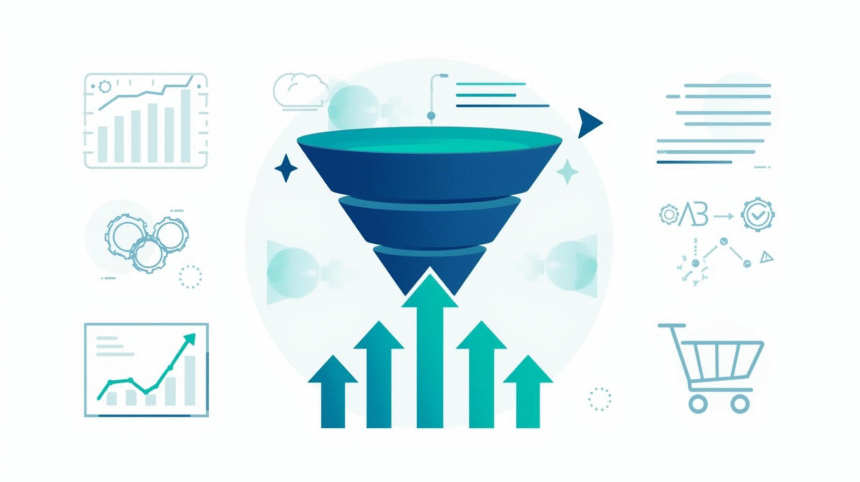Conversion Rate Optimization (CRO) is the systematic process of increasing the percentage of website visitors who take a desired action, such as making a purchase or signing up for a newsletter, by refining user experiences and removing barriers. In 2025, with eCommerce traffic booming and attention spans shrinking, CRO has become essential for businesses turning digital investments into revenue, potentially boosting conversions by 20-50% through data-driven tweaks. This comprehensive guide explores what CRO entails, why it matters for agencies like Inoviqa, the step-by-step implementation process, advanced strategies, and tools to achieve measurable results in a competitive online landscape.
- What Is Conversion Rate Optimization (CRO)?
- Why Conversion Rate Optimization Matters for Businesses in 2025
- How to Calculate Conversion Rate Optimization for Your Website
- Key Elements of CRO: The Step-by-Step Process
- Step 1: Understand Your Users and Set Goals
- Step 2: Audit and Analyze Your Website
- Step 3: Implement and Test Optimizations
- Step 4: Measure, Iterate, and Scale
- Best CRO Strategies for eCommerce Sites for Beginners
- Clear Value Proposition and Engaging Landing Pages
- Strong Calls to Action (CTAs) and Social Proof
- Simplify User Experience and Speed Optimization
- Personalization and A/B Testing
- Free Tools for Conversion Rate Optimization in Small Businesses
- How AI Helps in Conversion Rate Optimization Strategies 2025
- Common Mistakes in CRO and How to Avoid Them
- FAQ
- What is conversion rate optimization, and why does it matter for businesses in 2025?
- How to calculate conversion rate optimization for your website?
- Best CRO strategies for eCommerce sites for beginners?
- What is CRO in marketing, and how to implement it step by step?
- Free tools for conversion rate optimization for small businesses?
- Summary
What Is Conversion Rate Optimization (CRO)?
CRO involves analyzing user behavior on a website to identify friction points and optimize elements such as layouts, content, and calls to action (CTAs) that guide visitors toward conversions. Unlike broad marketing tactics, it focuses on post-traffic efforts, using tools like heatmaps and A/B testing to make incremental improvements that compound over time. For digital agencies, CRO bridges design and analytics, ensuring user-centric websites on platforms like Shopify or WordPress drive not just views, but actions.
At its core, CRO treats every visitor interaction as an opportunity, measuring success by the completion-to-session ratio. It evolved from basic A/B testing in the early 2010s to AI-powered personalization today, where algorithms predict user needs in real-time. Businesses ignoring CRO leave up to 70% of potential revenue on the table, as unoptimized sites lead to high bounce rates and lost trust.
CRO differs from SEO by prioritizing on-site engagement over organic traffic; while SEO attracts visitors, CRO converts them. For Inoviqa clients, this means tailoring service pages for lead generation, such as optimizing CTAs for consultations.
Quick Summary: CRO is about fine-tuning websites to maximize actions from existing traffic, blending analytics, design, and psychology for sustained growth.
Why Conversion Rate Optimization Matters for Businesses in 2025
In 2025, CRO matters because rising ad costs and privacy regulations like GDPR make acquiring traffic expensive, shifting focus to squeezing more value from current visitors. Optimized sites can increase revenue by 30% without extra marketing spend, as seen in eCommerce, where average CRO hovers at 2-3% but top performers hit 5-10%. For small businesses and agencies, it levels the playing field against giants by emphasizing user trust and seamless experiences.
Beyond revenue, CRO enhances user satisfaction, reducing cart abandonment (often 70%) through personalized journeys and faster load times—Google notes a 1-second delay cuts conversions by 20%. It aligns with trends like mobile-first design and AI chatbots, ensuring compliance and accessibility. Agencies like Inoviqa use CRO to deliver ROI-proof services, tracking metrics that tie optimizations to client goals, such as higher sign-ups.
Ignoring CRO risks stagnation; with AI search evolving, unoptimized sites fade in relevance. Data shows CRO adopters see 15% higher customer lifetime value through repeat engagements.
How to Calculate Conversion Rate Optimization for Your Website
Calculating CRO starts with defining clear goals, such as form submissions or purchases, then using the formula: (Number of Conversions / Total Visitors) × 100. For a site with 10,000 monthly visitors and 300 sales, the rate is 3%—benchmark against industry averages (e.g., 2.5% for retail) to set targets. Tools like Google Analytics track these automatically via goal setup, segmenting by source or device for deeper insights.
To deepen analysis, calculate macro (primary actions, such as buys) and micro (secondary actions, such as add-to-cart) rates to reveal funnel leaks. For example, if micro rates are high but macro rates are low, focus on checkout friction. Recalculate weekly to measure tweaks, aiming for 1-2% monthly lifts through iterative testing.
For Inoviqa, we audit baselines during onboarding and use custom dashboards to forecast the impact of CRO changes, such as CTA redesigns. Common pitfalls include ignoring traffic quality—such as filtering out bots or low-intent sources—for accurate baselines.
Quick Summary: Accurate CRO calculation provides a baseline for optimization, guiding data-backed decisions across the funnel.
Key Elements of CRO: The Step-by-Step Process
Step 1: Understand Your Users and Set Goals
Begin by auditing user data via surveys, heatmaps (e.g., Hotjar), and analytics to map behaviors and pain points. Define SMART goals —such as “increase email sign-ups by 20%” — tied to business objectives, and segment audiences by demographics or journey stage. This user-first approach uncovers why 50% of visitors bounce, informing targeted fixes.
Deeper dive: Conduct qualitative interviews or session replays to uncover frustrations, such as confusing mobile navigation for eCommerce, and segment high-intent traffic by ad vs. organic. Agencies refine this using tools like Microsoft Clarity to gain range-click insights.
Step 2: Audit and Analyze Your Website
Perform a comprehensive audit using free tools like Google PageSpeed Insights to assess speed and accessibility, identifying issues that can drop conversions by 7% per second. Review funnel drop-offs using flow reports, prioritizing high-traffic pages such as landing pages.
Advanced: Use Crazy Egg’s scroll maps to see engagement zones that correlate with bounce rates. For Inoviqa clients, we create heatmaps of service pages to identify where users abandon lead forms. Benchmark against competitors via tools like SEMrush Site Audit.
Step 3: Implement and Test Optimizations
Run A/B or multivariate tests on elements like headlines or buttons using Optimizely’s free tier, measuring uplift over 2-4 weeks with statistical significance. Start small: Test CTA colors on landing pages, expecting 10-20% lifts from high-contrast designs.
In depth: For Shopify stores, test personalized recommendations via apps like Nosto and track add-to-cart increases. Iterate based on results—winners scale site-wide. Common: 80/20 rule, where 20% of changes drive 80% gains.
Step 4: Measure, Iterate, and Scale
Post-test, analyze with GA4 for ROI, then scale successes while A/B testing variants. Quarterly reviews ensure ongoing relevance amid algorithm changes.
Quick Summary: The CRO process is iterative: Research, audit, test, and refine to build a high-converting site.
Best CRO Strategies for eCommerce Sites for Beginners
Clear Value Proposition and Engaging Landing Pages
Craft headlines that solve pain points, like “Boost Sales 30% with Our Analytics”—test for clarity to reduce confusion. Align landing pages with ad intent, using visuals and testimonials to build trust, cutting abandonment by 25%.
Deeper: For beginners, use Unbounce templates for mobile-optimized pages and incorporate urgency cues like “Limited Stock.” Case: Amazon’s personalized landing pages lift conversions by 35%.
Strong Calls to Action (CTAs) and Social Proof
Design CTAs with action verbs (“Get Started Free”) in contrasting colors, placing them above the fold and within the post content. Add reviews or badges to leverage social proof, increasing trust and clicks by 15-20%.
Advanced: A/B test phrasing like “Buy Now” vs. “Add to Cart” on Shopify, using Fomo apps for scarcity. Inoviqa integrates this for CRO audits, resulting in an 18% uplift in lead forms.
Simplify User Experience and Speed Optimization
Streamline navigation and forms—reduce fields to essentials and offer guest checkout to drop abandonment by 45%. Optimize speed with image compression and CDNs, as 53% abandon slow sites.
In practice: Use Google’s Mobile-Friendly Test; for eCommerce, lazy-load images. Beginners can start with WP Rocket Lite, a free version.
Personalization and A/B Testing
Tailor content via first-party data, like dynamic pricing, boosting relevance and conversions by 20%. Run tests on high-traffic elements, using VWO for beginners.
Quick Summary: Beginner strategies focus on friction removal and testing, yielding quick wins for eCommerce CRO.
Free Tools for Conversion Rate Optimization in Small Businesses
Hotjar offers free heatmaps and surveys for user insights, ideal for spotting drop-offs. Google Optimize (free tier) enables A/B testing without code.
Crazy Egg’s basic plan tracks clicks affordably; combine with GA4 for funnel analysis. For Inoviqa, these tools audit client sites pre-optimization.
Quick Summary: Free CRO tools provide essentials for minor ops, scaling to pro levels.
How AI Helps in Conversion Rate Optimization Strategies 2025
AI analyzes patterns for predictive personalization, like recommending products via tools like Dynamic Yield, boosting conversion rates by 15%. It automates testing with Optimizely AI, suggesting variants faster.
Deeper: In 2025, AI chatbots (e.g., Intercom free tier) guide users, reducing support queries by 30%. For agencies, AI forecasts benchmarks and integrates with GA for real-time tweaks.
Challenges: Bias in data—audit regularly for fairness.
Common Mistakes in CRO and How to Avoid Them
Overlooking mobile (40% of traffic) leads to 50% of conversions being lost—always test responsiveness. Ignoring qualitative data biases toward numbers; balance with feedback.
Rushing tests without significance wastes resources—aim for 1,000+ samples. For beginners, skip vanity metrics like page views; focus on funnel completion.
Quick Summary: Avoid pitfalls by prioritizing mobile, data balance, and proper testing for effective CRO.
FAQ
What is conversion rate optimization, and why does it matter for businesses in 2025?
CRO maximizes actions from traffic, mattering for revenue growth amid high acquisition costs.
How to calculate conversion rate optimization for your website?
Use (Conversions / Visitors) × 100, tracking via GA goals.
Best CRO strategies for eCommerce sites for beginners?
Focus on CTAs, speed, and social proof for quick lifts.
What is CRO in marketing, and how to implement it step by step?
Audit, test, iterate—start with user research.
Free tools for conversion rate optimization for small businesses?
Hotjar and Google Optimize for insights and tests.
Summary
Conversion Rate Optimization (CRO) transforms websites from passive viewers into active converters through user analysis, strategic tweaks, and ongoing testing —essential for 2025 success. Key takeaways: Calculate baselines accurately, implement beginner-friendly strategies such as strong CTAs and speed fixes, leverage free tools and AI for depth, and avoid common data balance errors. For Inoviqa clients, start with a free audit to unlock 20-30% gains—contact us to optimize your site today, and share your CRO wins in the comments. Subscribe for more on analytics and web strategies.






